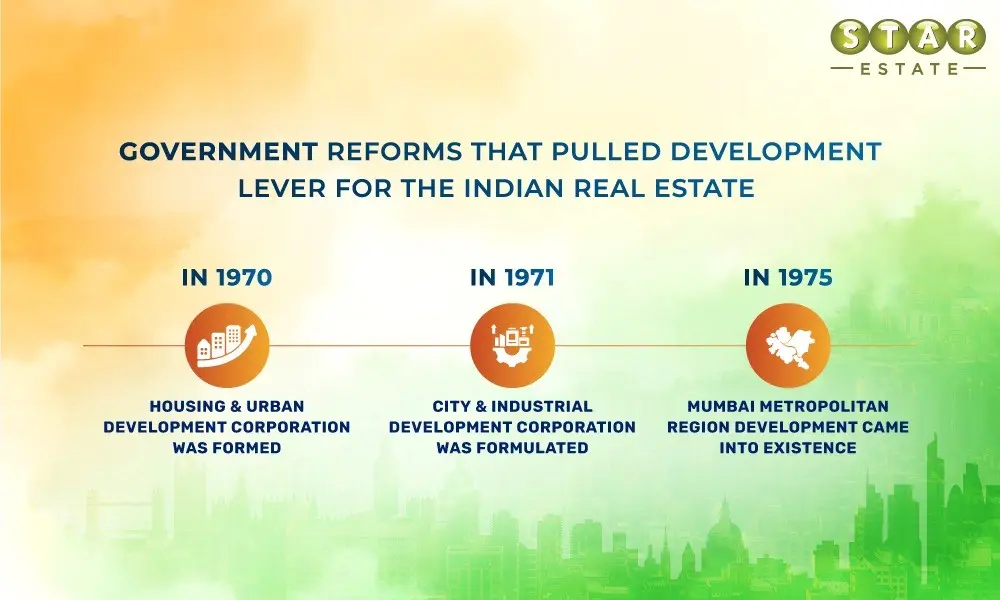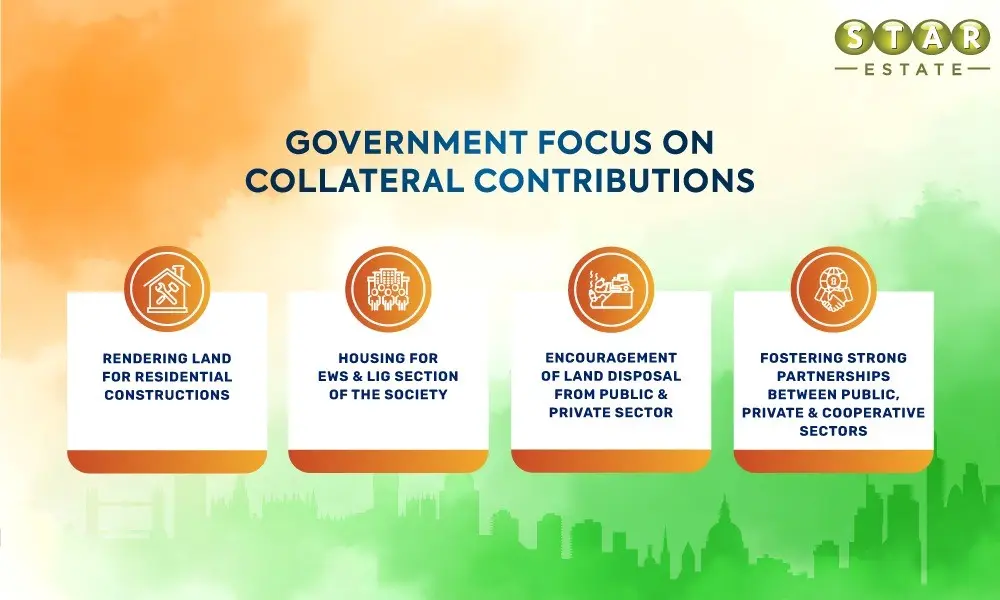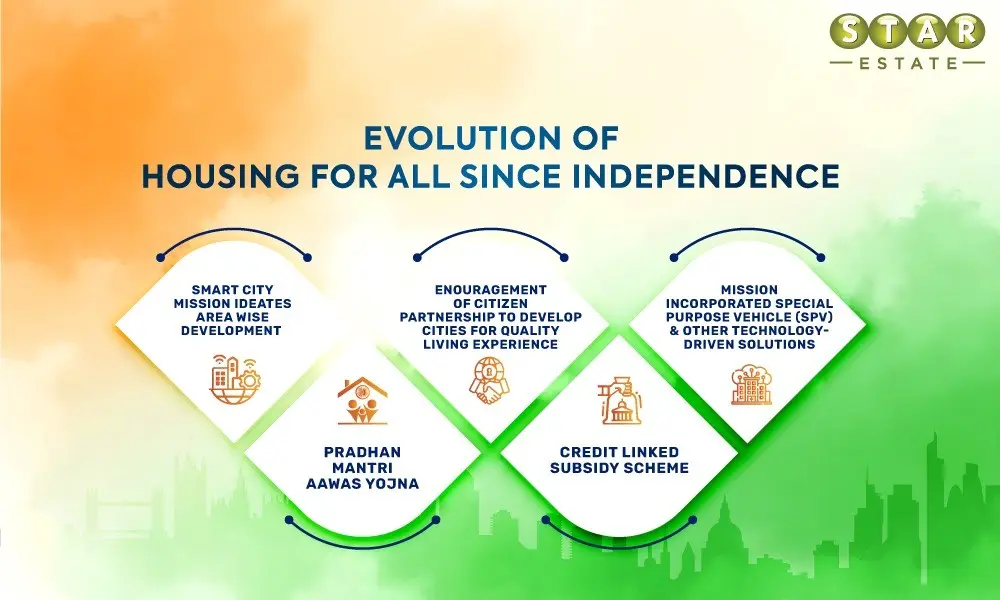Independence Day Spl – 15 Milestone Decisions which Redefined Indian Real Estate
As the nation celebrates 78 years of independence, the Indian real estate also enjoys a major share of the pie of economic growth. After evolving as an identity of being a housing demand provider to the second largest employer after agriculture, the Indian property market has many synonyms. While Bharat rushes to become the world’s third-largest economy by 2030, here are the 15 major milestones that set the tone of Viksit Bharat in 2047.
 Independence Day Spl – 15 Milestone Decisions which Redefined Indian Real Estate
Independence Day Spl – 15 Milestone Decisions which Redefined Indian Real EstateIndian real estate has undergone revolutionary advancements since independence. Now, with technology and urbanization advancing rapidly, the real estate sector in India aims to reach a trillion-dollar marketplace. The synchronized working with allied industries and continuous job creation leads to innovative expansion to render immovable assets to every Indian.
Here, we shed light on the top 15 landmark decisions that redefined the Indian real estate market.
Recap | History of Indian Real Estate
Parallel to the nation, the real estate market in India has held from centuries. However, a major turnaround took place as many foreign entities came for business and gradually manifested ownership.
While some gave us historical monuments, some left Bharat, the country land with streamlined administrative buildings and robust infrastructure of their time.
Post-Independence Era – Foundation of Real Estate Sector
While the exit of colonial rule set the stage for India to shine in its own way under democratic rule. The key real estate reforms in India laid the foundation for a robust nation, despite the socio-political backdrop was hit hard by turbulent times.
The 1950s -1960s era marked the capital cities, and the national capital adapted its maiden Development Plan (Delhi Development Plan) during this period. Inspired by the meticulously planned city of Chandigarh, Maharashtra the state on the western coastline, formed the Maharashtra Regional and Town Planning Act 1966.

Alongside this, the Government introduced real estate initiatives in India to cater to housing demand. Distinguished residential complexes and colonies were planned for Government employees and low-income groups. In the 1990s, the introduction of the Private Public partnership model was also amongst major milestone events in the Indian property market.
Since independence, several landmark decisions in Indian real estate have unfolded. However, the PM Narendra Modi-led Government gave a massive boost to the market. With the introduction of stringent laws, transparency in property transactions, and women's empowerment via ownership make real estate outshine.
Affordable Housing since 1950s
A major challenge for the Government of India since independence has been meeting the demand for residential units. With the partition line drawn, rendering housing to citizens and migrants coming in from the other side of the border becomes a responsibility. Citing this, the Indian Government has timely incorporated the best housing policies in India till 2025.
Introduced as a planned development, India witnessed major transformation under its umbrella. The maiden national housing board was formulated in 1950. The initiative to build budget-friendly residential units continued with the formulation of the National Housing and Habitat Policy (NHHP) in 1998 and the 74th Constitution amendment of 1992.
Jawaharlal Nehru National Urban Renewal Mission 2005 was another landmark decision for Indian real estate. It aimed implementation of reform-driven advancement of urban infrastructure.
Main objectives of Government’s real estate initiatives in India from decades focus on:

Under the scheme, the Government of India aimed to construct 1.5 million residential units for the urban poor from 2005-2012.
Pradhan Mantri Aawas Yojna
Launched in 2015, Pradhan Mantri Awas Yojana is among the top milestone events in the Indian property market. Under this scheme, the Indian Government aimed to render pucca housing for all. The scheme introduced in two sections – PMAY urban and PMAY rural, focused on a home for every family across the length and breadth of the nation.
The stringent rules ensured every family reap the benefits of this initiative. Like applicant must not own a residential property in his/her name. Also, the housing unit allocation will be in the name of female head of the family.
CLSS – Credit Link Subsidy Scheme
The scheme marks a robust extension of the PMAY scheme as the Government aims to render maximum housing facilities. The introduction of CLSS allows homebuyers to avail of a loan at cheaper interest rates.
In 78 years of Independence, the Credit Link Subsidy Scheme is recorded amongst important real estate reforms in India. This initiative aims to render financial support for homebuying to families with distinct income potential. Including Economically Weaker Section (EWS), Lower Income Groups (LIG), and Middle Income Group (MIG).
Smart City Mission
Another landmark decision for Indian real estate was taken by the Government of India in 2015. The launch of the Smart City Mission in 100 cities was launched with the aim of offering a green and sustainable environment. The Government aimed to foster urban design to cultivate economic growth by infusing robust infrastructure.

Benami Act
Earlier introduced as the Benami Transactions (Prohibition) Act in 1988, the Indian Government exhibited a commitment to seize unnamed properties. The act, however, was amended in 2016 and was renamed as the Prohibition of Benami Property Transactions Act 1988.
Under the act, any Indian citizen participating in a Benami transaction will be eligible for punishment. The property proved not beneficial to immediate family members, including wife/husband or unmarried daughter, will be aforesaid to be Benami property.
Complete FDI in Indian Real Estate
The concept of (FDI) foreign direct investment in the Indian real estate sector was initiated in 2005. The then Union Government of India opened the door for foreign investors via liberalization. The green signal to let foreign realtors develop shopping malls in the country was the stepping stone for FDI in the country.
Before 2005, FDI didn’t have a stronghold in the Indian real estate market. Despite thumbs up from the Indian Government, the socio-economic situation and change in power center did make foreign players hesitant to invest in India.
However, the scenario altered post-2005 as the Central Government pushed for better infrastructure. Thus, the liberties of FEMA Act 1999 acted as a toolkit to welcome global private players for nation-building.
REIT – Real Estate Investment Trust
REIT, a modern and alternative investment option in India, is among the major real estate reforms in India. Interestingly, the foundation for this investment portfolio was laid back in 2010. But the unclear structure stalled REIT’s execution. However, the current Union Government in its maiden stint cleared the way for streamlining operations in the real estate investment trust.
RERA – Real Estate Regulatory Authority
Established in 2016, the RERA Act brings transparency in the property business via stringent rules. Now, developers must receive a certificate of completion and occupancy along with several other sanctions from respective agencies.
Also, it is important to follow the timeline for project completion laid out by RERA. Several other corrective including penalties, create a strong sense of responsibility amongst developers. Thus, the long waiting period for property buyers despite making timely payments is a thing of the past now. With these many features, RERA has become one of the best real estate initiatives in India.
GST – Goods and Services Tax
The Indian real estate didn’t remain untouched by the concept of one nation, one tax ratio. Here, several important norms are kept out of the tax ambit, while the incorporation of elements from auxiliary industries does make tax payable.
Online Tax Payment
One of the major real estate reforms in India is the online payment of property tax. The ease of property tax submission eliminates delay and long-standing queues. Also, the online availability of tax details online, acts as a transparent real estate work mechanism.
Technological Advancement
The nation, Bharat, has come a long way since independence, and technological advancement has contributed to rapid urbanization. With the strengthening of India’s socio-economic condition, the dreams of young India to own immovable assets are also cherished via technological advancement.

From traditional residential pattern to urban living experience a lot has altered as technology took the center stage. A leap of technological update help investors with virtual tour of the property with a single click. Like these there are more important milestone events in Indian property market.
Online Property Search
With income growth and widening accessibility of the internet, online businesses are flourishing massively. Going with the flow, the Indian real estate market also switched to the online business trend. Thus, aspiring property owners and investors found a better way to find immovable assets. The online property search portals are best to find properties that align with their budget and requirements.
Co-Working Spaces
The availability of commercial spaces for business operations outshines with co-working spaces. A major reason for the increase in demand for the workplace is self-employment. The start-ups and other business companies with limited presence in a geographic location prefer to rent the minimum space.
Thus, many reputed developers introduce co-working spaces like WeWork to cater to this requirement.
Green Housing
While pollution is taking a toll on health, sustainable features create a better living experience. The addition of solar panels and rainwater harvesting is among the best sustainable features. Also, the segregated waste disposal is one of the ways to initiate clean living.
These 15 milestone decisions redefined the Indian real estate market, which is now expected to reach a new high by 2030.
You May Also Like: Why Premium Homes in India are high in Demand?
You May Also Like: Fractional Ownership Explained
Best Christmas Decor Ideas for...